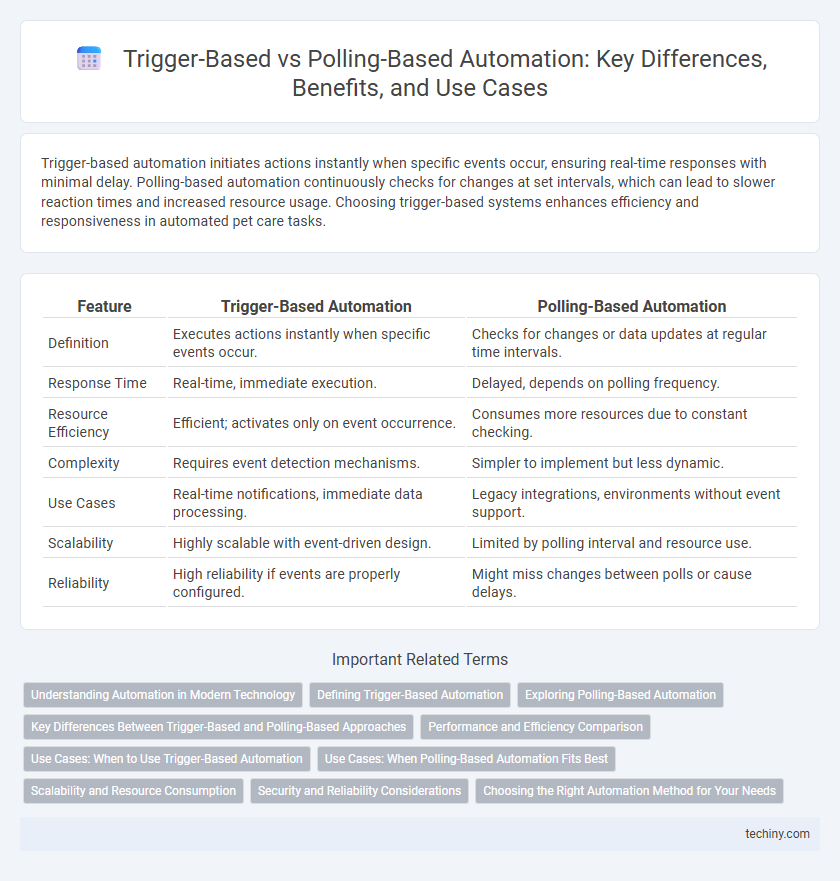Trigger-based automation initiates actions instantly when specific events occur, ensuring real-time responses with minimal delay. Polling-based automation continuously checks for changes at set intervals, which can lead to slower reaction times and increased resource usage. Choosing trigger-based systems enhances efficiency and responsiveness in automated pet care tasks.
Table of Comparison
| Feature | Trigger-Based Automation | Polling-Based Automation |
|---|---|---|
| Definition | Executes actions instantly when specific events occur. | Checks for changes or data updates at regular time intervals. |
| Response Time | Real-time, immediate execution. | Delayed, depends on polling frequency. |
| Resource Efficiency | Efficient; activates only on event occurrence. | Consumes more resources due to constant checking. |
| Complexity | Requires event detection mechanisms. | Simpler to implement but less dynamic. |
| Use Cases | Real-time notifications, immediate data processing. | Legacy integrations, environments without event support. |
| Scalability | Highly scalable with event-driven design. | Limited by polling interval and resource use. |
| Reliability | High reliability if events are properly configured. | Might miss changes between polls or cause delays. |
Understanding Automation in Modern Technology
Trigger-based automation offers real-time response by executing tasks immediately when specific events occur, enhancing efficiency in dynamic systems. Polling-based automation relies on periodic checks to detect changes, which can introduce latency but offers simplicity in implementation. Modern technology favors trigger-based methods for seamless integration with IoT devices and event-driven architectures, optimizing resource usage and system responsiveness.
Defining Trigger-Based Automation
Trigger-based automation initiates actions immediately when specific events or conditions occur, enabling real-time responsiveness and minimizing latency in workflows. It relies on event-driven architecture, where systems listen for triggers such as data changes, user interactions, or system alerts to execute predefined tasks. This approach enhances efficiency and accuracy by reducing unnecessary resource consumption compared to polling-based automation, which continuously checks for changes at regular intervals.
Exploring Polling-Based Automation
Polling-based automation continuously checks a system or data source at regular intervals to detect changes or updates, enabling timely responses without relying on external triggers. This method is beneficial in environments where real-time event notifications are unavailable or unreliable, ensuring consistent data synchronization and process automation. However, polling can introduce latency and increased resource consumption compared to trigger-based approaches, necessitating efficient scheduling and resource management strategies.
Key Differences Between Trigger-Based and Polling-Based Approaches
Trigger-based automation initiates workflows instantaneously when specific events occur, ensuring real-time processing and minimizing delays. Polling-based automation relies on periodic checks to detect changes or updates, which can introduce latency and increased resource consumption. The key differences lie in their responsiveness, efficiency, and suitability for time-sensitive applications, with trigger-based methods offering faster reaction times and improved scalability compared to polling-based approaches.
Performance and Efficiency Comparison
Trigger-based automation delivers superior performance and efficiency by instantly responding to events without continuous resource consumption, unlike polling-based automation that repeatedly checks for updates, causing higher latency and increased system load. Trigger systems reduce unnecessary API calls and accelerate processing times, optimizing resource usage and minimizing operational costs. Polling mechanisms introduce delays and consume bandwidth inefficiently, making them less suitable for real-time or high-frequency automation scenarios.
Use Cases: When to Use Trigger-Based Automation
Trigger-based automation is ideal for real-time applications such as instant notifications, order processing, and fraud detection where immediate response is critical. It is highly effective in systems requiring minimal latency, event-driven workflows, and precise action initiation upon specific triggers like user interactions or sensor data. Organizations benefit from trigger-based automation when accuracy and speed are essential to enhance operational efficiency and customer experience.
Use Cases: When Polling-Based Automation Fits Best
Polling-based automation fits best in use cases requiring periodic checks for data updates when APIs lack real-time event support, such as legacy systems or external services without webhook capabilities. It is ideal for batch processing tasks where data consistency over intervals is crucial, including inventory synchronization in e-commerce or scheduled report generation. This approach ensures reliable monitoring despite potential delays, making it suitable for monitoring non-critical systems where immediate response is not mandatory.
Scalability and Resource Consumption
Trigger-based automation offers superior scalability by processing events in real-time, reducing latency and minimizing resource consumption compared to polling-based automation, which continuously checks for changes regardless of event occurrence. Polling-based systems generate unnecessary overhead and increased network traffic, leading to higher CPU and memory usage that can hinder performance as system demands grow. Efficient trigger mechanisms enable dynamic resource allocation, supporting scalable infrastructure while conserving bandwidth and processing power.
Security and Reliability Considerations
Trigger-based automation enhances security by transmitting data only upon specific events, reducing exposure to unauthorized access and minimizing attack surfaces. Polling-based automation, while reliable in data retrieval consistency, increases vulnerability risks due to continuous requests, potentially leading to data leaks or overload attacks. Choosing trigger-based methods improves real-time responsiveness and lowers system resource usage, ensuring a more secure and reliable automation process.
Choosing the Right Automation Method for Your Needs
Trigger-based automation executes tasks instantly when specific events occur, ensuring real-time responsiveness and reduced system resource usage. Polling-based automation periodically checks for changes, suitable for environments where event hooks are unavailable or unreliable but can introduce latency and higher resource consumption. Selecting the right method depends on factors like system capabilities, latency tolerance, and resource constraints to optimize performance and efficiency.
Trigger-Based Automation vs Polling-Based Automation Infographic

 techiny.com
techiny.com